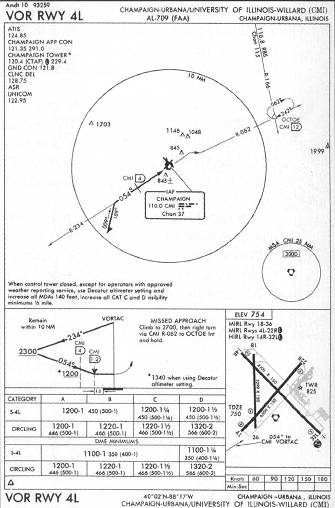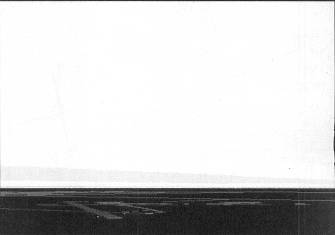Microsoft Flight Simulator Handbook
by Jonathan M. Stern
Terminal VOR Approach
Champaign, Illinois, is served, in addition to other IAPs, by two terminal VOR approaches. You can try the VOR Rwy 4L IAP by taking off from runway 32L, turning left and flying outbound for approximately five miles, executing the procedure turn to reverse course and fly inbound, and flying the approach inbound to landing. Figure 18.11 shows the VOR Rwy 4L IAP chart.

You can tell by a number of things on the chart that this is a terminal VOR approach:
- As reflected in both the plan view and the profile view, the missed approach point is the VORTAC. The Champaign VORTAC appears to be located near the center of the airport.
- The time-distance table at the bottom of the chart is blank. There is no time from the VORTAC to the missed approach point, because the VORTAC marks the missed approach point.
Given your intent to take off from runway 32L, you can plan out how you will use the IAP to fly the approach. On the plan view, you can see that you will turn left and track outbound on the 234 degree radial until you pass the intersection at 4.0 DME. You then will fly a procedure turn, turning first to the left to a heading of 189°. One minute thereafter, you will make a right turn to a heading of 009° and maintain that heading until you reintercept the inbound course of 54°.
The approach course will take you to the VORTAC, which is the missed approach point. If the weather is IMC, you should study the missed approach procedure, which, in this case, calls for a climb to 2,700 feet, followed by a right turn to fly the 62 degree radial outbound to OCTOE intersection.
From the profile view, you fill in the altitude information for your approach. You should climb to a minimum altitude of 2,300 feet while flying outbound and maintain 2,300 feet during the procedure turn. After completing the procedure turn within 10 nautical miles of the VORTAC and reintercepting the final approach course inbound, the aircraft can be descended to 1,200 feet.
Upon reaching the 4.0 DME point, the aircraft can be descended to the MDA, 1,100 feet. You can see that there are two sets of minima. The second set is labeled DME MINIMUMS and contains a slightly lower MDA for straight-in approaches than does the first set. Because you have DME, you use the second set, The touchdown zone elevation, as shown in the airport sketch, is 750 feet.
The profile view also depicts a VDP, or visual descent point. VDPs appear only on non-precision approaches. The VDP marks the point where descent from the MDA can be made on a normal glidepath. If the aircraft is capable of identifying the VDP, which your DME-equipped Cessna is, the airplane cannot be descended below the MDA until the VDP is reached.
Now you can fly the approach:
- Locate the Cessna on runway 32L at Champaign using the World/Airports menu and selecting from the Chicago area scenery.
- Use the World/Weather menu to program clouds with bases at 1,150 feet and tops at 3,000 feet. Set the coverage to overcast. This will keep you in the clouds throughout much of the approach.
- Set up for the approach before taking off. Tune the NAV 1 radio to the Champaign VORTAC, frequency 110.0. Rotate the OBS until the OBI reads 234 degrees.
- Apply full throttle and make a normal takeoff.
- Immediately after takeoff, turn left and intercept the 234 degree radial while climbing to 2,300 feet. Use a 90 knot cruise-climb speed for good visibility over the nose, good engine cooling, and an acceptable climb rate. Reduce the manifold pressure to 23" Hg and set the propeller for 2,400 RPM in the climb.
- You want to fly past the 4.0 DME point, but you must plan the procedure turn so that it will be completed within 10 nautical miles of the VORTAC. The procedure turn altitude provides proper terrain and obstruction clearance only within the 10-mile limitation. If you fly beyond 10 nautical miles from the VORTAC during the procedure turn, you may risk collision with obstructions or terrain.
- When you are at or above 2,300 feet and more than 4.0 DME from the VORTAC, you can begin the procedure turn. Turn left to a heading of 189 degrees, as indicated in the procedure turn symbol on the chart. Note the time (minutes and seconds) when you start the turn. During the outbound procedure turn, slow the aircraft to 90 KIAS (if it was ever accelerated beyond 90 knots). Rotate the OBS until the OBI reflects the inbound course of 054 degrees.
- At the completion of one minute, begin a right standard rate turn to heading 009 degrees. As the VOR needle moves off the left stop of the display, start a turn paced so that you roll out on a heading of 054° as the CDI centers within the bullseye. Use standard VOR tracking procedures to track the inbound course toward the airport.
- As soon as the inbound course is intercepted, you may begin a descent to 1,200 feet. As you pass 4.0 DME inbound, you should lower the landing gear, begin your descent to the MDA, 1,100 feet, and perform the Before Landing checklist. Again, the GUMP check should identify any gear problems and ensure that the engine controls are in the proper configuration for a possible go around. This approach is a bit unusual in that the MDA is only 100 feet below the previous altitude on the approach.
- When you reach 1,100 feet, you must level the aircraft and remain at or above 1,100 feet until you have the runway environment in sight and are in a position from which a landing can be made using normal maneuvers and procedures. Moreover, with the VDP identifiable at 1.2 DME, you must remain at or above 1,100 feet until you reach it.
Figure 18.12 shows the view out the windscreen at the VDP. Notice how the view correlates to the course arrow in the airport sketch on the IAP chart. From the VDP, the profile view reflects that there is one mile to fly to the runway threshold. In that one mile, you have 350 feet to descend to the TDZE.
Figure 18.12. At the VDP, the VASI shows that you are on a proper glidepath.
- If the conditions permit, proceed with the landing. If not, execute the missed approach procedure and request further clearance from ATC.
Table of Contents
Previous Section: Non-Terminal VOR Approach
Next Section: VOR-DME Approach
